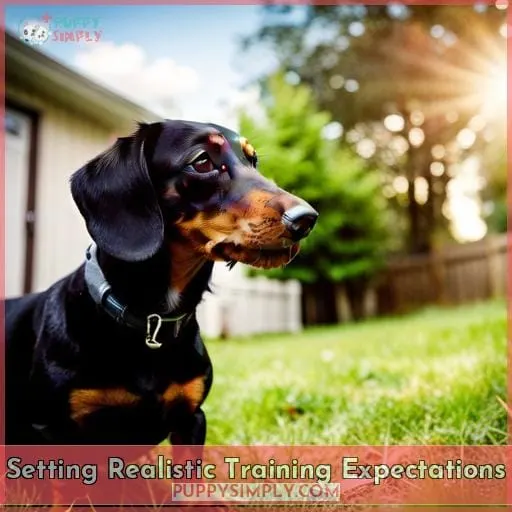This site is supported by our readers. We may earn a commission, at no cost to you, if you purchase through links.
 Did you know that 81% of Dachshund owners feel their dogs are easy to train?
Did you know that 81% of Dachshund owners feel their dogs are easy to train?
If you feel like your Dachshund is stubborn and impossible to train, you’re not alone.
But with the right approach, you can train your Dachshund to be a well-behaved and obedient companion.
This article will provide you with tips and tricks to help you train your Dachshund successfully.
Table Of Contents
Key Takeaways
- 81% of dachshund owners report their dogs are easy to train
- Dachshunds are intelligent but require patience and consistency in training
- Misconceptions exist about dachshunds lacking intelligence or being untrainable
- Patience, clear communication, and positive reinforcement lead to dachshund training success
Are Dachshunds Easy to Train?
When you’re considering getting a Dachshund, you’d be forgiven for wondering if their reputation for stubbornness makes them impossible to train.
While Dachshunds are intelligent dogs, their training does require more patience and consistency than other breeds.
Their tenacious hunting background means they’ll employ independent thinking and problem-solving skills, which can manifest in stubborn behaviors.
However, using positive reinforcement techniques tailored to their unique temperament, setting clear expectations, and committing to ongoing training, Dachshunds can learn basic commands, tricks, and good manners.
The key is never giving up, even when progress seems slow.
With the proper techniques and expectations, Dachshunds can be a joy to train.
Dachshund Training Misconceptions
Your Dachshund’s reputation for being stubborn and impossible to train stems from some common misconceptions about their breed.
One of the biggest misconceptions is that Dachshunds aren’t intelligent, which couldn’t be further from the truth.
Another misconception is that they’re untrainable due to their independent nature. While it’s true that Dachshunds can have a strong-willed personality, with effective training techniques and consistent practice, they can be trained just like any other breed.
It’s important to understand that behavioral challenges may arise during training, but don’t let these discourage you!
With patience, clear communication, and positive reinforcement techniques tailored specifically for your dachshund’s behavior traits, you’ll achieve success in training your beloved furry friend.
Why Dachshunds Can Be Challenging
But wait – while Dachshunds may seem stubborn, the truth is they can actually be quite eager to learn when trained properly.
The key is understanding their background as hunting dogs. Dachshunds are problem-solvers by nature who’ll creatively work to get what they want.
This means you need extra consistency and patience to shape their behavior. Set very clear expectations and reinforce them continuously – Dachshunds will unlearn quickly without this.
You also must outsmart them by making training intrinsically rewarding through play, praise, and high-value treats.
While they may test your limits, Dachshunds can reach advanced obedience when positive methods are tailored to their unique temperament.
Approach challenges as puzzles to solve together, not battles of will.
With insight and compassion, you can gain an attentive best friend.
Setting Realistic Training Expectations
You’ll need to set realistic expectations when training your Dachshund.
Training a Dachshund takes time and patience.
Don’t expect overnight miracles.
Measure progress in small increments.
Celebrate little wins along the way.
Communicate clearly and consistently.
Dachshunds want to understand what you want.
Have patience during setbacks.
Stay positive and keep at it.
Progress fluctuates.
Understand the Dachshund mindset.
Their stubbornness comes from an independent spirit hardened by their breeding to ferret out badgers.
Reward their problem-solving successes.
With realistic expectations, clear communication, patience, and understanding, you can train your Dachshund effectively.
Setting your Dachshund up for steady progress makes training enjoyable for both of you.
Key Training Milestones for Dachshunds
When training your Dachshund puppy, focus on the key periods:
-
Between birth and 12 weeks old:
- Early socialization
- Basic behavior and command training
- Developing good habits around housetraining, chewing, and jumping
-
Between 3 to 9 months old:
- Continue socialization
- Advanced obedience training
- Addressing specific behavioral problems
Stay patient and consistent through these milestones to set your stubborn pup up for training success.
Birth to 12 Weeks
One must prioritize early socialization and basic training during a Dachshund puppy’s first 12 weeks of life.
This includes:
- Daily handling and weight tracking by the breeder.
- Introducing noises like whistles while feeding at 3 weeks.
- Beginning simple behaviors like sit and stay in short 5-minute training sessions starting at 8-12 weeks once the puppy goes home.
Focus on positive housetraining, crate training, leash walking fundamentals, and socialization during this critical window for developing good behaviors.
3 to 9 Months
Someone must teach appropriate digging, encourage positive behavior, and restrict jumping off furniture.
Compete in agility at 18 months with low jumps during this stage.
As your dachshund explores more independence, continue reinforcing training through short, focused sessions.
Be patient when adolescent challenges arise and persist with socialization strategies and leash training tips tailored to this breed’s needs.
Top 5 Dachshund Training Tips
When training your Dachshund, stick to positive reinforcement techniques.
Keep your training sessions short and focused to avoid frustration.
Eliminating distractions, while being patient and consistent, will set you and your dog up for success.
Use Positive Reinforcement
You should use positive reinforcement when training your Dachshund as it builds trust and encourages repetition of desired behaviors.
Reward good behavior with treats, praise, play.
Keep rewards small and frequent at first.
Vary rewards to maintain motivation.
Never punish or scold, as this destroys trust.
Use positive reinforcement for the best chance at Dachshund training success.
Stay patient, consistent, and always reinforce wanted behaviors.
This allows you to overcome challenges posed by their willful nature while building a strong bond.
Keep Sessions Short
Your positive-reinforcement training’s effectiveness relies on keeping dachshund sessions brief initially.
As a puppy, short 5-minute training interludes build focus and prevent boredom before it forms.
Quick progress motivates a dachshund to learn more.
Expand session duration and challenge when basic commands stick.
But remember—quality over quantity enables effective training.
| Command | Duration |
|---|---|
| Sit | 30 sec – 1 min |
| Down | 30 sec – 1 min |
| Stay | 30 sec – 1 min |
Eliminate Distractions
However, if you want to achieve maximum effectiveness in training sessions, it’s recommended to eliminate distractions, such as other pets, children, loud noises or tempting items, so your dachshund stays focused exclusively on you and the task at hand.
This level of attention and concentration from your dog facilitates learning behaviors rapidly and correctly.
Quiet room
Short sessions
Engaging rewards
Minimal noise
Few distractions
Be Patient and Consistent
Despite their reputation for stubbornness, with time and dedication on your part, Dachshunds can learn.
Consistency and patience are key in training a Dachshund. Set realistic expectations for their progress and be prepared to reinforce behaviors continuously. Use positive reinforcement, keep sessions short and focused, and equip yourself with the right tools.
| Command | Definition |
|---|---|
| Sit | Dog sits back on hindquarters with front legs straight on the floor. |
| Down | Dog lays down on its belly with legs tucked under its body. |
| Stay | Dog remains in the sit or down position until released. |
| Come | Dog moves toward and sits in front of the handler. |
| Heel | Dog walks by the handler’s left side, head at knee level. |
Essential Gear for Training a Dachshund
The gear you’ll need for effective Dachshund training includes:
- A comfortable harness and leash
- Motivational treats
- A crate
- Toys to hold their attention during short sessions
Invest in a well-fitted harness designed specifically for Dachshunds’ unique body shape. This will allow you to reinforce leash manners without putting pressure on their delicate backs.
Fill a treat pouch with tiny training tidbits to motivate your pup during five-minute bursts.
Set up a properly sized crate with blankets and chew toys to make it cozy while preventing destructive chewing tendencies.
Rotate noisy, food-dispensing, and interactive toys to pique your dog’s interest, challenge their problem-solving skills, and prevent boredom or frustration.
Choosing the right accessories tailored to your Dachshund’s needs paves the way for stress-free, engaging training.
Frequently Asked Questions (FAQs)
How old should my dachshund be when I start training?
Begin training your dachshund between 8-12 weeks old.
Enroll them in puppy kindergarten and obedience classes as early as possible for optimal training success.
Be patient, consistent, and use positive reinforcement techniques in short, engaging sessions until good behaviors are mastered.
What kind of treats work best for training dachshunds?
When training dachshunds, use irresistible, aromatic treats like bits of chicken, cheese, or hot dogs.
Keep training sessions short and sweet, praising your pup and rewarding good behavior immediately with those savory snacks.
This positive reinforcement builds the bond between you and your eager student.
How can I stop my dachshund from barking excessively?
Try determining the cause first.
If your dachshund barks for attention, ignore them.
For alarm barking, acknowledge then redirect their focus.
Use treats and praise to reinforce quiet behavior.
Consistency is key, so everyone in the household should follow the same approach.
Should I use a clicker when training my dachshund?
Yes, using a clicker can be an effective training tool for your dachshund.
The click marks desired behaviors precisely.
Then reward your pup.
This clear communication establishes connections rapidly in their bright minds.
Consistency matters most; a clicker simply streamlines training.
Stay patient, keep it positive.
Focus on progressively strengthening good habits through practice.
What commands are the most important to train a dachshund?
Sit and stay for safety.
Come for reliability.
Leave it for household manners.
Heel for leashed walks.
Quiet for reducing barking.
Reinforce these often with rewards and patience.
A well-trained dachshund is a happy, secure companion.
Conclusion
To successfully train your Dachshund, it’s important to understand their unique traits and approach training with patience and consistency.
While some may view Dachshunds as stubborn and impossible to train, with the right techniques and expectations, they can be obedient and well-behaved companions.
Remember to use positive reinforcement, keep sessions short, eliminate distractions, and be patient.
With these tips and the right gear, you can overcome any training challenges and enjoy a harmonious relationship with your Dachshund.
So, don’t give up – train your Dachshund to be the best they can be!













